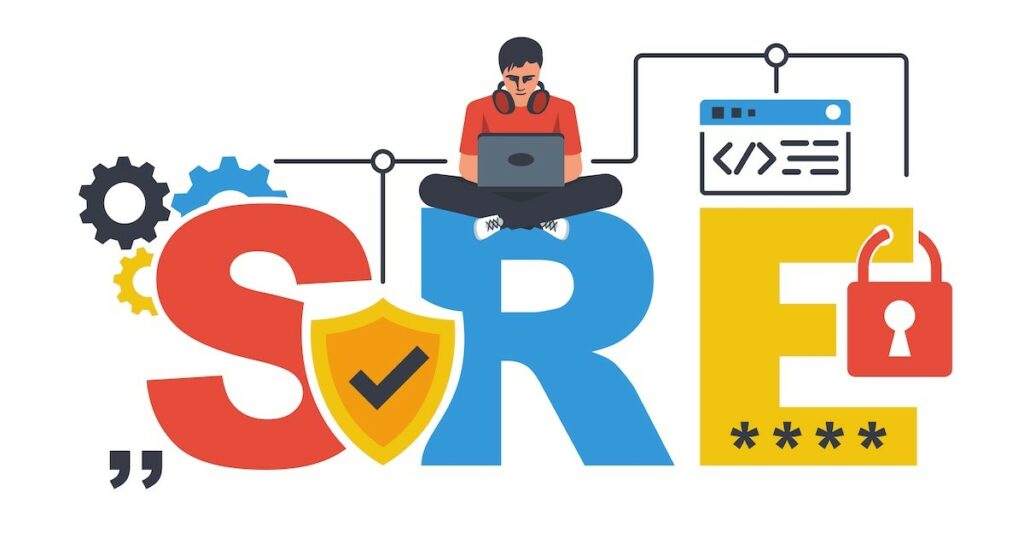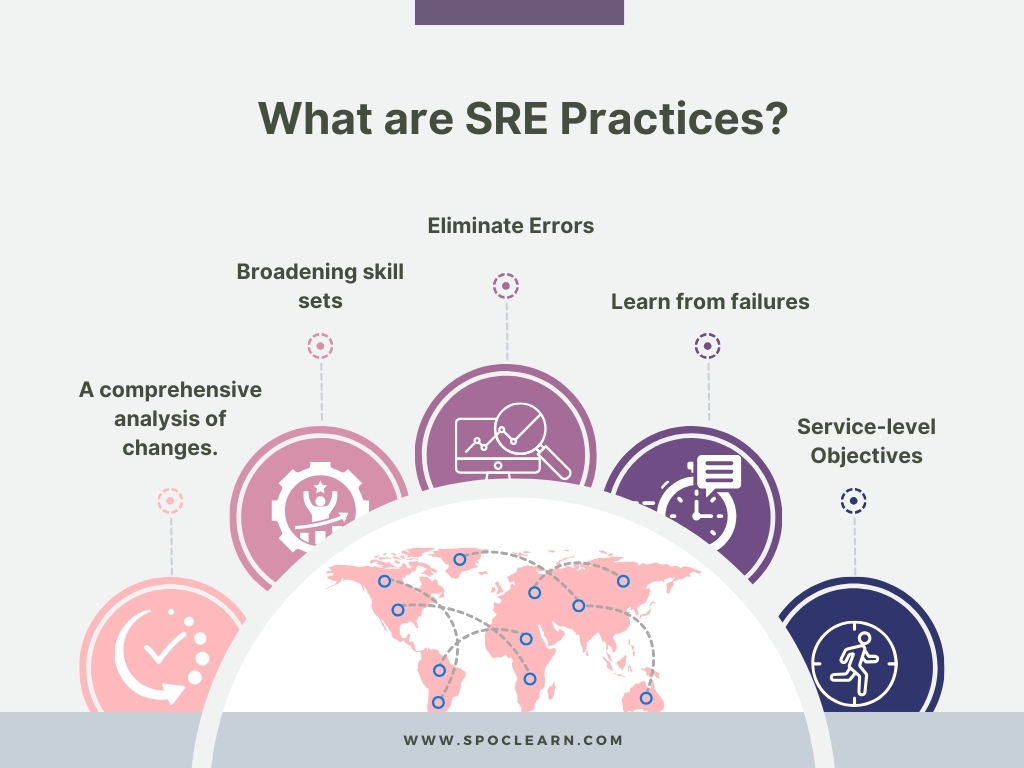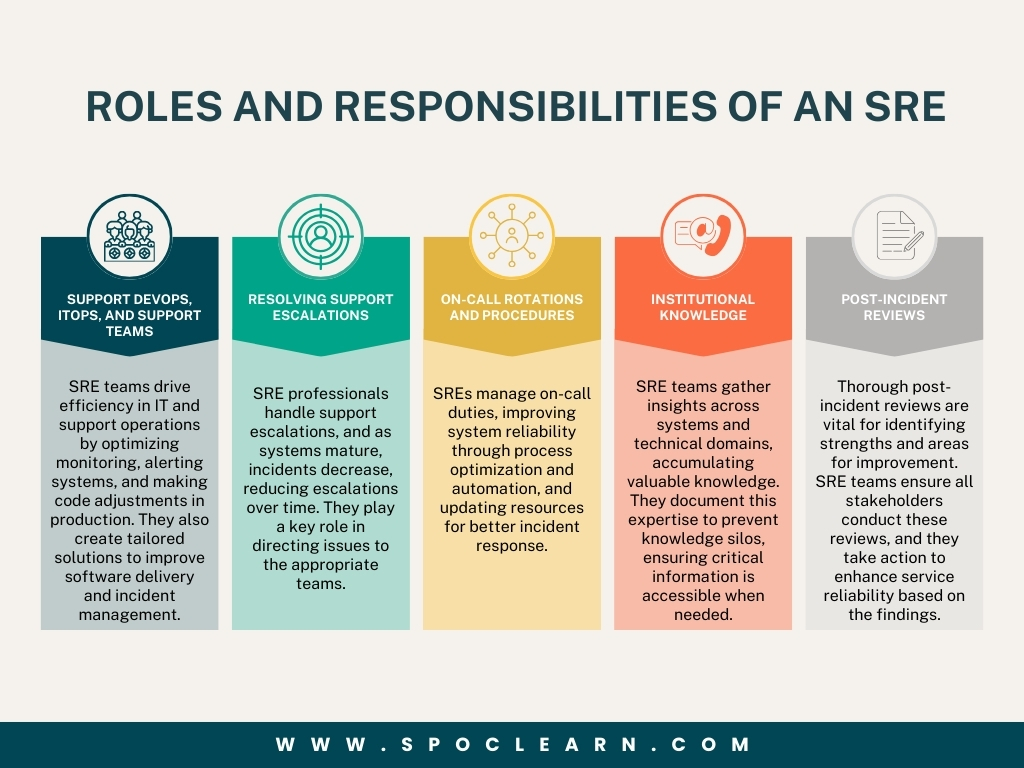Table of Contents
ToggleSite Reliability Engineering or SRE is a specialized field dedicated to addressing the complexities inherent in managing expansive, extensively distributed systems. It leverages software engineering methodologies within operational and infrastructural frameworks, with the primary objective of enhancing system dependability while minimizing the duration required for outage detection and recovery. Site Reliability Engineers serve as a conduit for aligning developers and IT operations, facilitating cohesion even within a DevOps-centric environment. Keep scrolling through the blog to learn more about Site Reliability Engineering.

Top 5 Key Practices of SRE
DevOps has fostered a collective responsibility for the dependability of both applications and infrastructure. While this represents a significant stride forward, it doesn’t inherently empower teams to fortify their systems proactively. Despite the implementation of streamlined feedback loops and enhanced collaboration, numerous DevOps teams continue to face challenges associated with deploying new, potentially unreliable services into production at an accelerated pace.

Looking for DevOps Certification? Check out our latest DevOps Certification Courses
Site Reliability Engineering serves as a conduit for harmonizing the efforts of developers and IT operations, even within a DevOps-oriented framework. It’s not about pitting SRE against DevOps; rather, it’s about integrating SRE practices within DevOps methodologies. SRE functions akin to a more proactive iteration of quality assurance (QA). Dedicated site reliability engineers are tasked with continuously enhancing the reliability of systems in production, encompassing tasks such as issue resolution, incident response, and often on-call duties.
The image below shows how SRE has evolved since its beginning:

Image source: blog.logrocket.com
Also, we have this SRE Certification Course specially tailored for enthusiasts who are looking for SRE jobs in this competitive market.
Amid its burgeoning significance, SRE’s notable contribution lies in its establishment of the four golden signals of monitoring:
- Latency
- Traffic
- Errors
- Saturation

Implementing site reliability engineering (SRE) practices within your development and operational frameworks may initially seem challenging, but adhering to a strategic approach and embracing SRE best practices can facilitate the process. Here are five advantageous practices to enhance your operational efficiency:
1. Take a Comprehensive Approach to Change Analysis
Utilizing SRE involves adopting a holistic perspective when addressing issues and solutions. By embracing this approach, organizations can assess incidents comprehensively, identifying the root causes of changes and understanding their impact on interconnected systems and processes. Holistic change analysis empowers development and operations teams to assess both immediate and long-term ramifications effectively.
2. Enhance Skill Diversity
Successful implementation of SRE requires a team of highly skilled engineers and architects capable of navigating dynamic product environments and cloud-based operations. To cultivate such expertise, it’s essential to invest in ongoing skill development initiatives. Implementing comprehensive training and professional development programs not only boosts the productivity of existing teams but also fosters the evolution of traditional teams into proficient SRE specialists, thereby aligning with organizational objectives.
3. Minimize Redundancy
SRE principles advocate for automation and the reduction of manual redundancies wherever possible. By embracing SRE, organizations can automate tasks from inception, ensuring swift service delivery to customers. Proactive adoption of automation minimizes redundancy and duplication of effort, enhancing productivity and mitigating the risk of manual errors.
4. Embrace a Culture of Learning from Failures
With an unwavering focus on reliability and service availability, SRE emphasizes continuous service improvement. This necessitates a culture that values learning from postmortems and embracing failure as an opportunity for growth. Analyzing incidents provides invaluable insights into the causes of failures, facilitating the identification of root causes and enabling teams to learn from mistakes. Leveraging these learnings bridges gaps, identifies areas for enhancement, and elevates overall performance and service reliability.
5. Define Clear Service-Level Objectives (SLOs)
Ensuring constant availability and reliability of services hinges on understanding user needs and expectations. To achieve this, organizations must establish clear service-level objectives (SLOs) as part of their service-level agreements. Defining SLOs enables organizations to align with end-user perspectives, optimize systems and applications accordingly, and uphold elevated uptime standards.
Top 5 Roles and Responsibilities of a Site Reliability Engineer
Integrating an SRE team offers substantial advantages to both IT operations and software development teams. Beyond enhancing system reliability in production environments, SRE implementation is poised to reduce the workload associated with support escalations, granting dedicated time for the development of new features and services.
Now, let’s delve into the typical roles and responsibilities associated with site reliability engineering, contrasting them with common DevOps roles and responsibilities.

1. Developing Tools to Support DevOps, ITOps, and Support Teams
SRE teams proactively design and implement services aimed at enhancing the efficiency of IT and support operations. This encompasses a spectrum of tasks, ranging from fine-tuning monitoring and alerting systems to making code adjustments directly in production environments. Site reliability engineers might be tasked with crafting bespoke solutions to address gaps in software delivery or incident management processes.
2. Resolving Support Escalations
Similarly, SRE professionals are often tasked with resolving support escalation cases. However, as SRE operations mature and systems become more robust, the frequency of critical incidents in production is likely to decrease, resulting in a decline in support escalations over time. Given their broad involvement across engineering and IT functions, SRE teams serve as valuable repositories of knowledge, facilitating the effective routing of issues to appropriate teams and individuals.
3. Optimizing On-Call Rotations and Procedures
Site reliability engineers frequently assume on-call responsibilities. In many organizations, the SRE role wields significant influence in refining system reliability through the optimization of on-call processes. SRE teams contribute to enhancing real-time collaborative responses to alerts by introducing automation and context. Moreover, they play a pivotal role in updating runbooks, tools, and documentation to better equip on-call teams for handling future incidents.
4. Capturing Institutional Knowledge
SRE teams acquire extensive insights into staging and production systems, as well as various technical domains within the organization. Through their engagement with software development, support, IT operations, and on-call duties, they accumulate invaluable historical knowledge over time. To prevent the siloing of this knowledge, site reliability engineers are tasked with documenting their expertise. Ongoing maintenance of documentation and runbooks ensures that teams have access to critical information when needed.
5. Facilitating Post-Incident Reviews
Thorough post-incident reviews are essential for identifying operational strengths and areas requiring improvement. SRE teams play a crucial role in ensuring that all stakeholders, including software developers and IT professionals, conduct comprehensive post-incident reviews. Subsequently, site reliability engineers are often assigned action items aimed at fortifying the reliability of services by refining aspects of the software development lifecycle or incident management processes based on review findings.
DevOps vs Site Reliability Engineer: Major Differences
Irrespective of the size and diversity of team compositions, it’s evident that DevOps is not a singular role or individual, unlike SRE. However, at the time of composing this article, there were approximately 25,000 DevOps Engineer positions advertised on Glassdoor, a figure comparable to the nearly 33,000 Site Reliability Engineers sought on the same platform.
A cursory analysis of job listings on Glassdoor indicates a significant overlap in backgrounds, responsibilities, and skill sets required for both roles. It appears that employers frequently interchange these job titles.
| DevOps | SRE | |
| Average Salary | The average DevOps Engineer compensation ranges from 2 to 6 years of experience and is 61,370 USD. | The average pay range for SREs at all levels of experience is $89000 to $166,000 |
| Experience | Agile Software Development Cloud Computing Scripting Languages Monitoring Systems Production Automation | Software EngineeringIT Operations Production Automation Cloud Computing Monitoring Systems Architecture |
| Key Responsibilities | Develop and manage system documentation design, build, and maintain core infrastructure. Diagnose the system and develop fixes Automate existing processes Monitor performances. | Develop and manage system documentation design, build, and maintain core infrastructure Diagnose the system and develop fixes. Automate existing processes monitor performances |
Top Benefits of SRE
Incorporating a fully functional Site Reliability Engineering (SRE) team within your organization offers numerous advantages. The primary objective of establishing an SRE team is to bridge the gap and address the disconnect between development and operations teams. Additionally, SRE brings about the following benefits:
1. Enhanced Customer Satisfaction
By prioritizing reliability, response times, and system performance, SRE significantly boosts customer satisfaction levels.
2. Increased Business Value
Through the provision of highly available, scalable, and reliable systems, SRE facilitates improved user satisfaction, higher customer retention rates, and greater business value generation.
3. Cost Reduction
SRE achieves cost savings through automation, infrastructure optimization, and effective incident management, thereby minimizing IT operations expenses.
4. Optimal Resource Utilization
By identifying inefficiencies and curbing overconsumption, SRE enables efficient infrastructure usage, thereby mitigating unnecessary costs.
5. Improved System Reliability
SRE promotes enhanced system reliability by implementing best practices in monitoring, incident management, error handling, security, and automation, thereby reducing downtime and service failures.
6. Expedited Incident Response and Recovery
Leveraging best practices in incident management, process automation, and playbook development facilitates quicker issue detection, diagnosis, and resolution.
7. Scalability and Performance Optimization
SRE assists in capacity planning and resource utilization optimization, facilitating the identification and resolution of scalability bottlenecks, performance enhancements, and the development of resilient systems.
8. Enhanced Collaboration and Alignment
By sharing reliability responsibilities with development teams, DevOps teams, and stakeholders, SRE fosters improved communication, cooperation, and alignment across teams.
9. Cultivation of a Continuous Improvement and Learning Culture
SRE teams foster a culture of continuous improvement and learning by embracing new technologies and practices, thereby driving innovation and efficiency within the organization.
Site Reliability Engineer Salary
SRE is a high-demand job that is globally skyrocketing and hence, organizations are looking for Certified Site Reliability Engineers. They are being compensated quite decently for their contribution and efforts.

Source: ZipRecruiter
Several factors influence the salary of a Site Reliability Engineer (SRE), such as your work experience, where you live, and your education. On average, SREs earn between $89,000 and $166,000 per year, but this can go higher depending on your performance and how much experience you have.
As you gain more experience, your salary tends to increase. For example, someone with an average of 3 years of experience might make around $107,567 per year, while senior SREs can earn even more.
Here’s a breakdown:
- With 3 years of experience: $116,049 per year
- In mid-career (4 to 6 years of experience): around $121,741 annually
- With 7 to 9 years of experience: about $124,643 per year
Job titles also play a role in salary. Site Reliability Engineer is just one title in this field, and you can move up to higher-paying positions as you gain more experience or pursue further education.
Here are some examples along with their average salaries:
- Director of Site Reliability Engineering: $172,603
- Senior Site Reliability Engineer: $136,456
- Lead Site Reliability Engineer: $122,985
- Site Reliability Engineer: $118,439
- Software Reliability Engineer: $113,558
Where you work also matters. Salaries for SREs can vary depending on location. For example, in tech hubs like San Francisco, salaries tend to be 18.3% higher than the national average. Companies like Google and Apple might offer around $140,000, while others like Equifax or Microsoft might offer different amounts. Considering the cost of living is important when evaluating salary benefits in your area.
Conclusion
Establishing a robust Site Reliability Engineering (SRE) team within your organization offers multifaceted benefits. By bridging the gap between development and operations teams, SRE initiatives enhance customer satisfaction, increase business value, and drive cost reduction. Moreover, SRE practices promote efficient resource utilization, improve system reliability, and accelerate incident response and recovery. Additionally, SRE activities contribute to scalability and performance optimization, foster collaboration and alignment among teams, and cultivate a culture of continuous improvement and learning.

© 2022 spoclearn.com